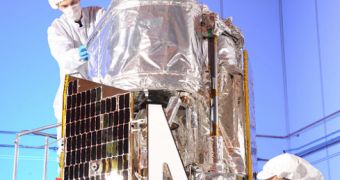Officials at the American space agency say that NASA's new X-ray space observatory, the Nuclear Spectroscopic Telescope Array (NuSTAR), was shipped to the California-based Vandenberg Air Force Base (VAFB) on Tuesday, ahead of its upcoming launch.
The vehicle was shipped out on Tuesday, January 24, and will reach the VAFB on January 27. This is where it will be mated with the Pegasus rocket that will launch it to space on March 14. Takeoff will occur from an aircraft based in the Kwajalein Atoll, the Marshall Islands.
The spacecraft, its instruments, and the Pegasus delivery system were all built by Dulles, Virginia-based Orbital Sciences Corporation. The L-1011 Stargazer aircraft will transport the rocket and its cargo to the Marshall Islands, and then launch them into space.
This small-explorer mission is managed by the Jet Propulsion Laboratory (JPL), in Pasadena, California, for the Science Mission Directorate at NASA Headquarters, in Washington, DC. Though relatively small, the spacecraft is extremely capable.
It was developed specifically to detect light emanating in X-ray wavelengths from various classes of objects, including Sun-like stars and supermassive black holes. NuSTAR's detectors are capable of detecting such objects at distances up to a few billion light-years away from Earth.
“The NuSTAR mission is unique because it will be the first NASA mission to focus X-rays in the high-energy range, creating the most detailed images ever taken in this slice of the electromagnetic spectrum,” says Fiona Harrison.
The expert is the principal investigator of the NuSTAR mission, and is based at the California Institute of Technology, in Pasadena. Caltech manages the JPL for NASA.
“NuSTAR is an engineering achievement, incorporating state-of-the-art high-energy X-ray mirrors and detectors that will enable years of astronomical discovery,” JPL project manager Yunjin Kim says, adding that the observatory's main telescope consists of two sets of 133 concentric shells of mirrors.
Given the long wavelength of X-rays, the observatory features a 10-meter (33-foot) mast, which JPL mission managers say will deploy about a week after NuSTAR is injected in its correct orbit. The mission is currently scheduled to last for about two years.
During this time, the telescope will conduct an in-depth survey of celestial X-ray sources, including stars, black holes, neutron stars, supernova remnants and other structures.
“NuSTAR will provide an unprecedented capability to discover and study some of the most exotic objects in the Universe, from the corpses of exploded stars in the Milky Way to supermassive black holes residing in the hearts of distant galaxies,” NASA Headquarters NuSTAR program scientist Lou Kaluzienski concludes.

 14 DAY TRIAL //
14 DAY TRIAL //